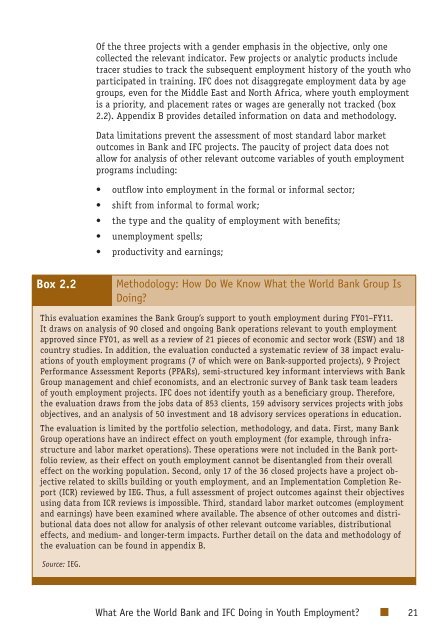Youth Employment Programs - Independent Evaluation Group
Youth Employment Programs - Independent Evaluation Group
Youth Employment Programs - Independent Evaluation Group
You also want an ePaper? Increase the reach of your titles
YUMPU automatically turns print PDFs into web optimized ePapers that Google loves.
Of the three projects with a gender emphasis in the objective, only onecollected the relevant indicator. Few projects or analytic products includetracer studies to track the subsequent employment history of the youth whoparticipated in training. IFC does not disaggregate employment data by agegroups, even for the Middle East and North Africa, where youth employmentis a priority, and placement rates or wages are generally not tracked (box2.2). Appendix B provides detailed information on data and methodology.Data limitations prevent the assessment of most standard labor marketoutcomes in Bank and IFC projects. The paucity of project data does notallow for analysis of other relevant outcome variables of youth employmentprograms including:• outflow into employment in the formal or informal sector;• shift from informal to formal work;• the type and the quality of employment with benefits;• unemployment spells;• productivity and earnings;Box 2.2Methodology: How Do We Know What the World Bank <strong>Group</strong> IsDoing?This evaluation examines the Bank <strong>Group</strong>’s support to youth employment during FY01–FY11.It draws on analysis of 90 closed and ongoing Bank operations relevant to youth employmentapproved since FY01, as well as a review of 21 pieces of economic and sector work (ESW) and 18country studies. In addition, the evaluation conducted a systematic review of 38 impact evaluationsof youth employment programs (7 of which were on Bank-supported projects), 9 ProjectPerformance Assessment Reports (PPARs), semi-structured key informant interviews with Bank<strong>Group</strong> management and chief economists, and an electronic survey of Bank task team leadersof youth employment projects. IFC does not identify youth as a beneficiary group. Therefore,the evaluation draws from the jobs data of 853 clients, 159 advisory services projects with jobsobjectives, and an analysis of 50 investment and 18 advisory services operations in education.The evaluation is limited by the portfolio selection, methodology, and data. First, many Bank<strong>Group</strong> operations have an indirect effect on youth employment (for example, through infrastructureand labor market operations). These operations were not included in the Bank portfolioreview, as their effect on youth employment cannot be disentangled from their overalleffect on the working population. Second, only 17 of the 36 closed projects have a project objectiverelated to skills building or youth employment, and an Implementation Completion Report(ICR) reviewed by IEG. Thus, a full assessment of project outcomes against their objectivesusing data from ICR reviews is impossible. Third, standard labor market outcomes (employmentand earnings) have been examined where available. The absence of other outcomes and distributionaldata does not allow for analysis of other relevant outcome variables, distributionaleffects, and medium- and longer-term impacts. Further detail on the data and methodology ofthe evaluation can be found in appendix B.Source: IEG.What Are the World Bank and IFC Doing in <strong>Youth</strong> <strong>Employment</strong>? 21
















